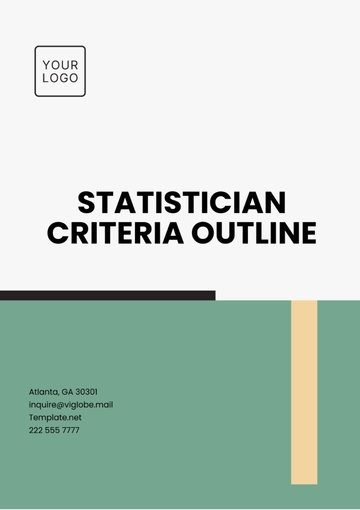Free Criteria

Prepared By: [YOUR NAME]
Date: January 1, 2050
Introduction
This document outlines the criteria for evaluating the Community Health Improvement Initiative. The purpose of these criteria is to ensure a systematic and objective assessment, facilitating informed decision-making and promoting transparency.
Purpose and Scope
The evaluation criteria aim to standardize the assessment of the Community Health Improvement Initiative, identify strengths and improvement areas, and ensure accountability and alignment with organizational goals. Applicable to all initiative aspects and stakeholders, evaluations will occur quarterly from January 1, 2050, to December 31, 2052.
Criteria Table
Criteria | Description | Weight (%) | Score (1-5) | Comments |
|---|---|---|---|---|
Relevance | Alignment with organizational goals, including access to healthcare and reducing health disparities. | 20% | ||
Impact | Measurable outcomes, such as the number of community members served and improvements in health metrics. | 25% | ||
Feasibility | Practicality of implementation, considering resource availability, budget constraints, and community engagement. | 20% | ||
Sustainability | Long-term viability post-implementation, including ongoing funding and community support plans. | 15% | ||
Stakeholder Engagement | Involvement and satisfaction of key stakeholders, incorporating feedback from community members and partners. | 10% | ||
Innovation | Creativity in approach, including unique outreach and education strategies for diverse populations. | 10% |
Scoring System
Each criterion will be evaluated on a scale of 1 to 5, where:
1 = Poor: Criteria not met, significant issues present.
2 = Fair: Some criteria were met, and moderate issues were present.
3 = Good: Criteria were mostly met, and minor issues were present.
4 = Very Good: Criteria met with few or no issues.
5 = Excellent: Criteria fully met, exemplary performance.
Evaluation Process
Preparation: Define the evaluation team, gather relevant materials, and ensure all evaluators understand the criteria.
Data Collection: Collect data through surveys, interviews with community members and stakeholders, document reviews of progress reports, and site visits to program locations.
Scoring: Each evaluator scores the criteria based on evidence gathered during the data collection phase.
Consensus Meeting: Convene the evaluation team to discuss scores, ensure consistency, and address discrepancies.
Final Report: Compile scores, comments, and recommendations into a final report that summarizes findings and suggests next steps for improvement.
- 100% Customizable, free editor
- Access 1 Million+ Templates, photo’s & graphics
- Download or share as a template
- Click and replace photos, graphics, text, backgrounds
- Resize, crop, AI write & more
- Access advanced editor
Streamline your decision-making process with the Criteria Evaluation Template from Template.net. This editable and customizable template allows you to assess various factors efficiently. Whether for business, education, or personal projects, this tool adapts to your needs. It's easy to edit directly in our Ai Editor Tool, ensuring that you can tailor every aspect to meet your criteria quickly and effectively.





























